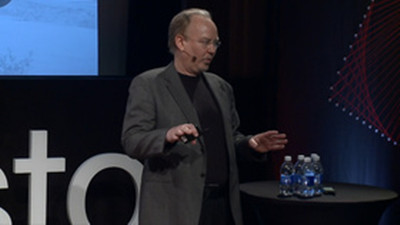Maybe not the way people dress, but you know, the question now is, how can we have all the good things that we identify with cities without all the bad things?
人們的衣著可能不會是這樣,但要知道,現在的問題是,我們要如何對于城市帶給我們的產物做到取其精華去其糟粕呢?
This is Bangalore. It took me a couple of hours to get a few miles in Bangalore last year.
這兒是班加羅爾,在去年的時我花了好幾小時才在班加羅爾移動了幾英里。
So with cities, you also have congestion and pollution and disease and all these negative things.
所以在城市里,有擁擠和污染有疾病還有很多負面的東西。
How can we have the good stuff without the bad?
怎樣取其精華去其糟粕呢?
So we went back and started looking at the great cities that evolved before the cars.
我們暫且回頭看看那么比較不錯的城市吧,在有了汽車之前的狀態。
Paris was a series of these little villages that came together, and you still see that structure today.
巴黎就是由好些小村莊合并而成的,這種分布結構你今天還可以看得出來。
The 20 arrondissements of Paris are these little neighborhoods.
巴黎的20個區就像20個小鄰居。
Most of what people need in life can be within a five- or 10-minute walk.
大多數人們的生活所需或許就在5到10分鐘的步行范圍里。
And if you look at the data, when you have that kind of a structure,you get a very even distribution of the shops and the physicians and the pharmacies and the cafes in Paris.
如果你去看那些數據,當你建立了這種結構后,巴黎的商店,內科醫生,藥房,還有咖啡廳都會很平均地分布在城市中。
And then you look at cities that evolved after the automobile, and it's not that kind of a pattern.
之后你再看那些擁有了汽車后的城市,他們就完全不是這個模式了
There's very little that's within a five minute walk of most areas of places like Pittsburgh.
像匹茲堡,大部分地方很少再有幾步之遙的生活了。
Not to pick on Pittsburgh, but most American cities really have evolved this way.
不單是匹茲堡,大部分美國的城市都演變成這個樣了。
So we said, we'll, let's look at new cities, and we're involved in a couple of new city projects in China.
所以我們說,看看這些新城市,我們也要在中國弄幾個新城市出來。
So we said, let's start with that neighborhood cell.
那我們就從社區單元開始著手吧。
We think of it as a compact urban cell.
我們覺得這是一種緊湊的城市單元。
So provide most of what most people want within that 20-minute walk.
這樣大部分人就能在20分鐘步程內滿足生活所需。
This can also be a resilient electrical microgrid,community heating, power, communication networks,etc., can be concentrated there.
這也能成為一種有彈性的微電網,社區供熱網,電力網,通訊網,等等,都能集中在那兒。
Stewart Brand would put a micro-nuclear reactor Stewart Brand right in the center, probably.
很可能會在正中心建一個原子核反應堆。
And he might be right.
他或許是對的。
And then we can form, in effect, a mesh network.
事實上,我們就能形成一個網狀網絡了。
It's something of an Internet typology pattern,so you can have a series of these neighborhoods.
這是一種類型學的互聯網模式,所以我們有了這一系列的社區。
You can dial up the density about 20,000 people per cell if it's Cambridge. Go up to 50,000,if it's Manhattan density. You connect everything with mass transit and you provide most of what most people need within that neighborhood.
你可以了解到人口密度,如果在劍橋大概就是每個社區2萬人。如果是在曼哈頓,這個數字就是5萬。我們把那些大的中轉點連接起來,這樣單在社區里就能滿足很多人的需求了。
You can begin to develop a whole typology of streetscapes and the vehicles that can go on them. I won't go through all of them. I'll just show one.
我們也能開創一個新的類型學包含了街景和交通工具,我就不詳講,我就說一個方面。
This is Boulder. It's a great example of kind of a mobility parkway, a superhighway for joggers and bicyclists where you can go from one end of the city to the other,without crossing the street, and they also have bike-sharing,which I'll get into in a minute.
這里是博爾德,它的駕車專用道路,還有跑步者和自行車者的高速公路,是很有代表性的,你可以順著它橫穿整個城市,不用過馬路,而且他們也有公共自行車能讓我很快就適應進去。
This is even a more interesting solution in Seoul, Korea.
在韓國首爾,還有個更有趣的解決方案。
They took the elevated highway, they got rid of it,they reclaimed the street, the river down below,below the street, and you can go from one end of Seoul to the other without crossing a pathway for cars.
他們放棄了高架公路,重新回到街道上,還有街道下面的小河流,這樣不用穿過馬路就能從首爾的一端到達另外一端。
The Highline in Manhattan is very similar.
曼哈頓的高壓線也是類似的情況。
You have these rapidly emerging bike lanes all over the world. I lived in Manhattan for 15 years.
在全世界,我們擁有這種迅速面世的單車道,我在曼哈頓住了15年。
I went back a couple of weekends ago, took this photograph of these fabulous new bike lanes that they have installed.
上幾個周末我回去了一趟給這些新建的漂亮的單車道拍了些照。
They're still not to where Copenhagen is, where something like 42 percent of the trips within the city are by bicycle.
比起哥本哈根,仍有些差距在哥本哈根,42%的路程都是在單車上的。
It's mostly just because they have fantastic infrastructure there.
很有可能是他們那里有更好的基礎設施。
We actually did exactly the wrong thing in Boston.
在波士頓我們完全做了錯誤的事。

We,the Big Dig,so we got rid of the highway but we created a traffic island and it's certainly not a mobility pathway for anything other than cars.
我們—那個大隧道,我們是擺脫了高速公路,但我們也制造了交通島顯然除了汽車,它還真的不適用于其他的交通工具。
Mobility on demand is something we've been thinking about, so we think we need an ecosystem of these shared-use vehicles connected to mass transit.
我們一直在思考迫在眉睫的流動性問題,我們覺得我們需要一個公交生態系統,他們可以將那些大的中轉站給連接起來
These are some of the vehicles that we've been working on.
這些是我們目前著手的一些交通工具。
But shared use is really key. If you share a vehicle,you can have at least four people use one vehicle,as opposed to one.
公共使用是關鍵,如果我們共用一輛車,那么相對一個人使用一輛車來說,這輛車的使用人數至少可以是四人。
We have Hubway here in Boston, the Velib' system in Paris.
在波士頓我們有Hubway。自行車共享系統,在巴黎有Velib系統。
We've been developing at the Media Lab this little city car that is optimized for shared use in cities.
我們在媒體實驗室研發這種城市小車,可以在城市充分共享使用。
We got rid of all the useless things like engines and transmissions. We moved everything to the wheels,so you have the drive motor, the steering motor,the breaking all in the wheel.
我們摒棄了那些沒什么用處的東西,像引擎還有傳動裝置,我們把一切都搬到輪子上,所以車上的輪子就集成有驅動馬達,轉向電機,和剎車系統。












